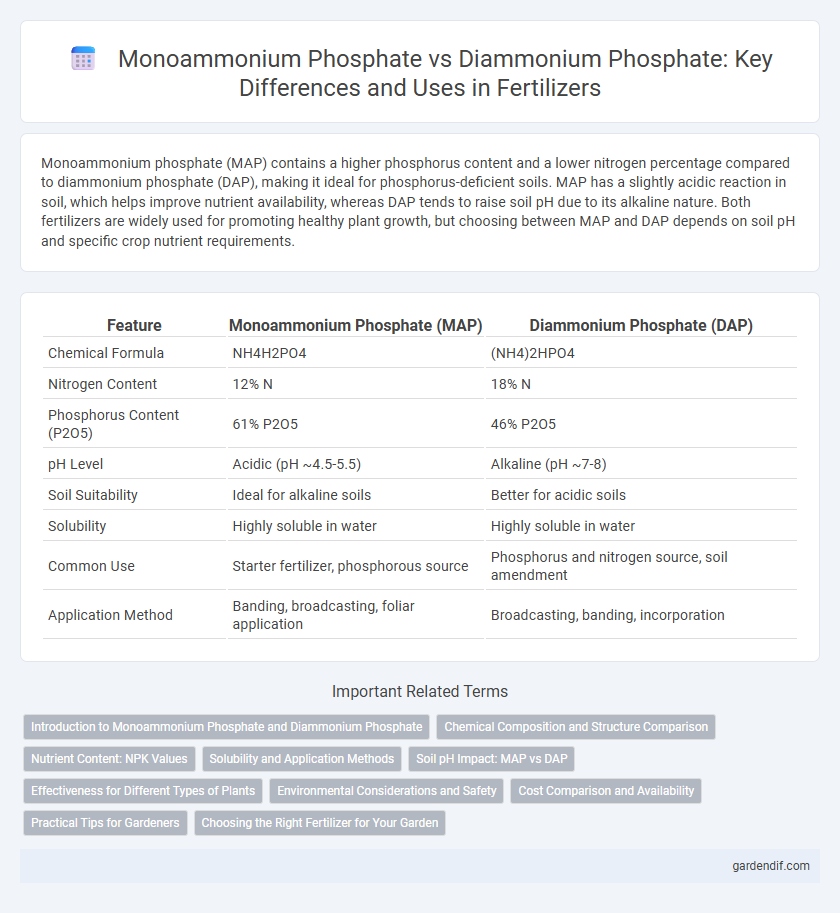
Monoammonium phosphate vs diammonium phosphate Illustration
Monoammonium phosphate (MAP) contains a higher phosphorus content and a lower nitrogen percentage compared to diammonium phosphate (DAP), making it ideal for phosphorus-deficient soils. MAP has a slightly acidic reaction in soil, which helps improve nutrient availability, whereas DAP tends to raise soil pH due to its alkaline nature. Both fertilizers are widely used for promoting healthy plant growth, but choosing between MAP and DAP depends on soil pH and specific crop nutrient requirements.
Table of Comparison
| Feature | Monoammonium Phosphate (MAP) | Diammonium Phosphate (DAP) |
|---|---|---|
| Chemical Formula | NH4H2PO4 | (NH4)2HPO4 |
| Nitrogen Content | 12% N | 18% N |
| Phosphorus Content (P2O5) | 61% P2O5 | 46% P2O5 |
| pH Level | Acidic (pH ~4.5-5.5) | Alkaline (pH ~7-8) |
| Soil Suitability | Ideal for alkaline soils | Better for acidic soils |
| Solubility | Highly soluble in water | Highly soluble in water |
| Common Use | Starter fertilizer, phosphorous source | Phosphorus and nitrogen source, soil amendment |
| Application Method | Banding, broadcasting, foliar application | Broadcasting, banding, incorporation |
Introduction to Monoammonium Phosphate and Diammonium Phosphate
Monoammonium phosphate (MAP) and diammonium phosphate (DAP) are essential phosphorus fertilizers widely used in agriculture. MAP contains 11% nitrogen and 52% phosphorus pentoxide (P2O5), providing a more acidic reaction in soil. DAP offers a higher nitrogen content of 18% and 46% P2O5, with an alkaline reaction, influencing nutrient availability and soil pH management.
Chemical Composition and Structure Comparison
Monoammonium phosphate (MAP) contains one ammonium ion (NH4+) and one phosphate ion (H2PO4-), resulting in a chemical formula of NH4H2PO4, while diammonium phosphate (DAP) consists of two ammonium ions and one phosphate ion with the formula (NH4)2HPO4. MAP has an acidic reaction in soil due to its lower pH, making it suitable for acidic or neutral soils, whereas DAP has a more alkaline effect because of its higher ammonium content. Structurally, MAP is more soluble and releases phosphorus and nitrogen more slowly compared to the higher nitrogen concentration and faster nutrient release found in DAP.
Nutrient Content: NPK Values
Monoammonium phosphate (MAP) typically contains an NPK ratio of 11-52-0, providing high phosphorus (P) with moderate nitrogen (N) and no potassium (K). Diammonium phosphate (DAP) offers a balanced NPK ratio of 18-46-0, featuring higher nitrogen content alongside substantial phosphorus and zero potassium. The choice between MAP and DAP depends on the specific nitrogen and phosphorus requirements of the crop, influencing nutrient management strategies.
Solubility and Application Methods
Monoammonium phosphate (MAP) exhibits higher solubility in water compared to diammonium phosphate (DAP), facilitating quicker nutrient availability for crops. MAP is commonly applied as a starter fertilizer or through fertigation due to its acidic reaction in soil, ideal for phosphorus and nitrogen uptake. DAP, with lower solubility and alkaline properties, is typically used in soil incorporation or broadcasting, promoting root development and balanced nutrient distribution.
Soil pH Impact: MAP vs DAP
Monoammonium phosphate (MAP) generally lowers soil pH due to its acidic nature, making it suitable for alkaline soils, whereas diammonium phosphate (DAP) tends to raise soil pH because of its alkaline effect, benefiting acidic or neutral soils. MAP has a pH impact typically around 4.5 to 5.5 in soil solution, promoting nutrient availability in high pH soils, while DAP pH ranges between 7.0 and 8.0, enhancing nutrient uptake by increasing soil alkalinity. Understanding these differences enables precise soil pH management to optimize crop nutrient absorption and yield.
Effectiveness for Different Types of Plants
Monoammonium phosphate (MAP) delivers phosphorus in a highly soluble form with a slightly acidic pH, making it ideal for acid-loving plants such as blueberries and azaleas. Diammonium phosphate (DAP) provides a higher nitrogen content and creates an alkaline environment, which suits neutral to alkaline soil preference in crops like corn and wheat. Plant nutrient uptake efficiency varies between MAP and DAP based on soil pH tolerance and specific growth requirements.
Environmental Considerations and Safety
Monoammonium phosphate (MAP) typically exhibits lower ammonia volatilization than diammonium phosphate (DAP), reducing nitrogen loss and minimizing atmospheric pollution. MAP's acidic pH also lowers the risk of soil alkalinity buildup compared to the more alkaline DAP, which can lead to soil degradation over time. Handling MAP is generally safer due to its lower dust generation and reduced potential for respiratory irritation, making it a preferable choice for environmental and occupational safety.
Cost Comparison and Availability
Monoammonium phosphate (MAP) typically offers a lower cost per nutrient unit compared to diammonium phosphate (DAP), making it a budget-friendly choice for phosphorus and nitrogen fertilization. Availability of MAP is generally higher in regions with intense crop production requiring acidic soil amendments, whereas DAP is more widely stocked due to its broader use and higher nitrogen content. Both fertilizers vary in price and accessibility based on regional demand, supply chain stability, and production costs.
Practical Tips for Gardeners
Monoammonium phosphate (MAP) offers gardeners a higher phosphorus content (12-61-0) ideal for promoting strong root development, while diammonium phosphate (DAP) provides more nitrogen (18-46-0), supporting vigorous leafy growth. Applying MAP is beneficial during early planting to enhance seedling establishment, whereas DAP suits mid-season feeding to boost overall plant health. Soil pH should be monitored as MAP tends to be more acidic, making it preferable for alkaline soils, whereas DAP raises pH, favoring acidic soils.
Choosing the Right Fertilizer for Your Garden
Monoammonium phosphate (MAP) offers a high phosphorus content ideal for promoting root development and early plant growth, making it suitable for phosphorus-deficient soils. Diammonium phosphate (DAP) contains more nitrogen, supporting vigorous vegetative growth, and is preferred when a nitrogen boost is needed alongside phosphorus. Selecting between MAP and DAP depends on soil nutrient levels and specific crop requirements, ensuring optimal fertilizer efficiency and healthy garden development.
Monoammonium phosphate vs diammonium phosphate Infographic

 gardendif.com
gardendif.com